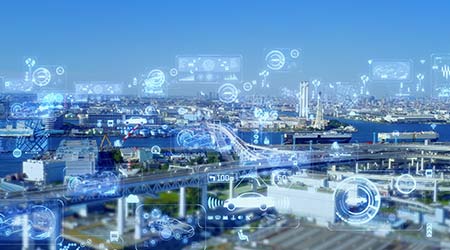How Digital Twins Technology Enables Smart Buildings, Smart Cities
Digital twins technology, combined with broadband and Internet of Things, can help dramatically reduce greenhouse gas emissions and mitigate climate change.
We all can relate to the experience of being in a building that is either over-heated or over-cooled with seemingly little connection to the time of day or year. In buildings where this is the case, the energy and cost savings are potentially endless. Reducing greenhouse gas (GHG) emissions in the building sector is critical to addressing climate change as 40 percent of GHG emissions come from buildings and 28 percent coming from building operations.
One emerging possibility for reducing greenhouse gas emissions is known as digital twins. Digital twins, paired with ubiquitous broadband, offers the building sector the promise of reducing both cost and emissions while improving operational efficiency and transparency.
What Is Digital Twins?
The concept of digital twins is twenty years old. IBM defines the technology as a “virtual representation of an object or system that spans its lifecycle, is updated from real-time data, and uses simulation, machine learning and reasoning to help decision-making.” Digital twins present an exciting option for innovation and sustainability in the urban environment and is why Venture Beat listed the technology as one of top five trends in 2021. But there are key components required for full optimization of digital twins in buildings – namely, significant investment in ubiquitous broadband, enabling the interconnectivity of sensors and other Internet of Things (IoT) devices wirelessly and securely (i.e., privacy preserving) in and around buildings to reduce operating costs, and at the same time, reduce GHG emissions.
This vision of an interconnected digital twinning of the built environment will take strong public-private coordination and collaboration between local, state and federal government as well as private firms in the tech startup industry. There are potential funding sources from the H.R. 3684 Infrastructure Investment and Jobs Act (IIJA), which includes a specific allocation of broadband infrastructure expansion grants, funding for energy data collection, and perhaps most unique to digital twins, information sharing of commercial building energy consumption.
There are several intriguing models of piloting digital twins technology, including the public-private partnership between the City of Las Vegas and two private firms, Cityzenith (digital twins software platform) and Terbine (IoT services and digital infrastructure management). Cityzenith focuses on developing urban digital twins to help decarbonize buildings and implement renewable energy systems to facilitate emissions reductions and improve performance for building owners.
The collaboration includes participation of property owners who input their data using a template, and the software creates a digital twin based on factors such as the building's age, condition, and purpose. The digital twin model is produced using Las Vegas’ existing IoT sensors and 5G network to collect real-time street-level data that will inform decisions about energy use, emissions, traffic, parking, noise, and emergency management. The digital twin also seeks to model scenarios addressing sustainability and mobility to improve operational efficiency and generate positive community outcomes in public wellbeing, education, safety, and economic development.
The City of Las Vegas is currently piloting projects to test the viability and validity of the technology, and if it proves itself worthwhile and beneficial, it plans to scale. Let’s hope that this recipe is replicable for other communities. But of significant note is the investment that Las Vegas has made in broadband/telecommunications infrastructure, which is a key enabling component of the project.
Metro21: Smart Cities Institute at Carnegie Mellon University (CMU), in Pittsburgh, has supported digital twin pilot projects, including the monitoring of energy and infrastructure systems for Mill19 at Hazelwood Green, led by Professors Burcu Akinci and Mario Berges. The project focused on the Continuous Commissioning process by resolving problems related to the operation of building systems, improving comfort, optimizing energy use and identifying retrofit opportunities. The goal is through the use and adoption of digital twins, combined with electrification, buildings can reduce their operating costs while also reducing GHG emissions.
It will take considerable investments from both the public and private sectors to make the shift to reducing GHG emissions in buildings, which will be the shift of buildings to all-electric (meaning that it encompasses not just the actual buildings, but also the entire site, including distributed energy sources). According to CMU School of Architecture Professor Vivian Loftness, the challenge is to reduce energy load, encourage conservation and track these data via building metering since it's hard to know what system is using which and how much of a particular energy source.
One significant breakthrough has been the introduction of 15-minute interval energy data and the ability to remotely access building automation systems. In this scenario, the building automation data belongs to building owners and is not publicly available, enabling building owners to have agency over the decision to make real-time adjustments based on performance metrics with the benefit being that their energy costs and GHG emissions both go down. Loftness says she believes that broadband is opening the opportunity to map buildings and compare them to the best-in-show, while digital twins could facilitate the creation of model buildings or standard operations and management protocol.
The United States is poised to be a leader in the reduction of GHG emissions through application of digital twin technology, and it’ll be exciting to see the expansion of case studies and models throughout the country. There is a long line of projects that are touting themselves as worthy of IIJA funding. Through collaborative and inclusive public-private partnerships utilizing digital twin technology in the building sector, the risks and rewards associated with these large capital investments will be shared and everyone wins, including the planet.
Karen Lightman is the Executive Director of Metro21: Smart Cities Institute at Carnegie Mellon University, one of two, Tier 1 research universities that call Pittsburgh home. She is an internationally recognized leader in building and supporting communities based on emerging technologies.
Related Topics:








